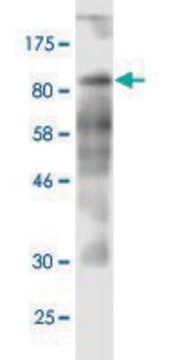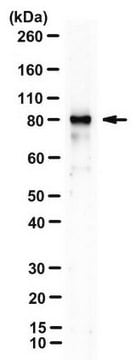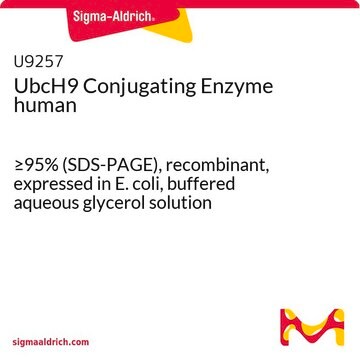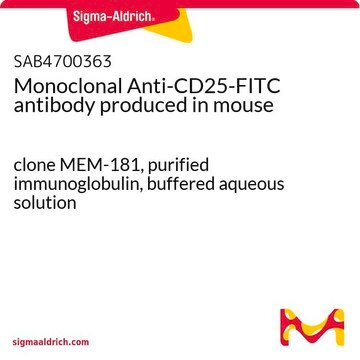MABT1548
Anti-CD97 Antibody, clone CLB‐CD97/1
Sinônimo(s):
Adhesion G protein-coupled receptor E5, Leukocyte antigen CD97
About This Item
Produtos recomendados
fonte biológica
mouse
Nível de qualidade
forma do anticorpo
purified antibody
tipo de produto de anticorpo
primary antibodies
clone
CLB?CD97/1, monoclonal
peso molecular
calculated mol wt 92 kDa
observed mol wt ~N/A kDa
purificado por
using protein G
reatividade de espécies
human
embalagem
antibody small pack of 100
técnica(s)
ELISA: suitable
flow cytometry: suitable
immunofluorescence: suitable
immunohistochemistry: suitable
immunoprecipitation (IP): suitable
inhibition assay: suitable
Isotipo
IgG2a
sequência de epítopo
N-terminal extracellular domain
nº de adesão de ID de proteína
nº de adesão UniProt
temperatura de armazenamento
-10 to -25°C
Informações sobre genes
human ... ADGRE5(976)
Especificidade
Imunogênio
Aplicação
Evaluated by Flow Cytometry in THP-1 cells.
Flow Cytometry Analysis: 1.0 µg of this antibody detected CD97 in one million THP-1 cells.
Tested Applications
Flow Cytometry Analysis: A representative lot detected CD97 in Flow Cytometry applications (Hamann, J., et al. (1996). 184(3):1185-9; Kwakkenbos, M.J., et al. (2002). J Leukoc Biol. 71(5):854-62).
Inhibition Assay: A representative lot of this antibody inhibited erythrocyte adhesion to CD97-transfected COS cells.(Hamann, J., et al. (1996). 184(3):1185-9; Hamann, J., et al. (1998). Eur J Immunol.;28(5):1701-7).
Immunoprecipitation Analysis: A representative lot immunoprecipitated CD97 in Immunoprecipitation applications (Hamann, J., et al. (1996). 184(3):1185-9).
Immunohistochemistry Applications: A representative lot detected CD97 in Immunohistochemistry applications (Hamann, J., et al. (1999). Arthritis Rheum. 42(4):650-8; Steinert, M., et al. (2002). Am J Pathol. 161(5):1657-67).
Immunofluorescence Analysis: A representative lot detected CD97 in Immunofluorescence applications (Hamann, J., et al. (1998). Eur J Immunol. 28(5):1701-7; Hamann, J., et al. (1999). Arthritis Rheum. 42(4):650-8; Steinert, M., et al. (2002). Am J Pathol. 161(5):1657-67).
ELISA Analysis: A representative lot detected CD97 in ELISA applications (Hamann, J., et al. (1999). Arthritis Rheum. 42(4):650-8; Steinert, M., et al. (2002). Am J Pathol. 161(5):1657-67).
Note: Actual optimal working dilutions must be determined by end user as specimens, and experimental conditions may vary with the end user.
Descrição-alvo
forma física
Reconstituição
Armazenamento e estabilidade
Outras notas
Exoneração de responsabilidade
Not finding the right product?
Try our Ferramenta de seleção de produtos.
Código de classe de armazenamento
12 - Non Combustible Liquids
Classe de risco de água (WGK)
WGK 2
Ponto de fulgor (°F)
Not applicable
Ponto de fulgor (°C)
Not applicable
Certificados de análise (COA)
Busque Certificados de análise (COA) digitando o Número do Lote do produto. Os números de lote e remessa podem ser encontrados no rótulo de um produto após a palavra “Lot” ou “Batch”.
Já possui este produto?
Encontre a documentação dos produtos que você adquiriu recentemente na biblioteca de documentos.
Nossa equipe de cientistas tem experiência em todas as áreas de pesquisa, incluindo Life Sciences, ciência de materiais, síntese química, cromatografia, química analítica e muitas outras.
Entre em contato com a assistência técnica





